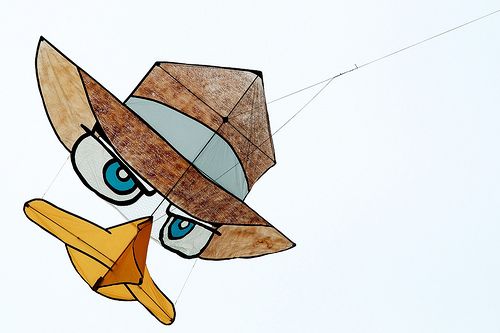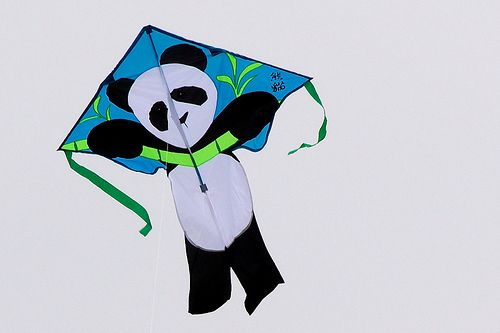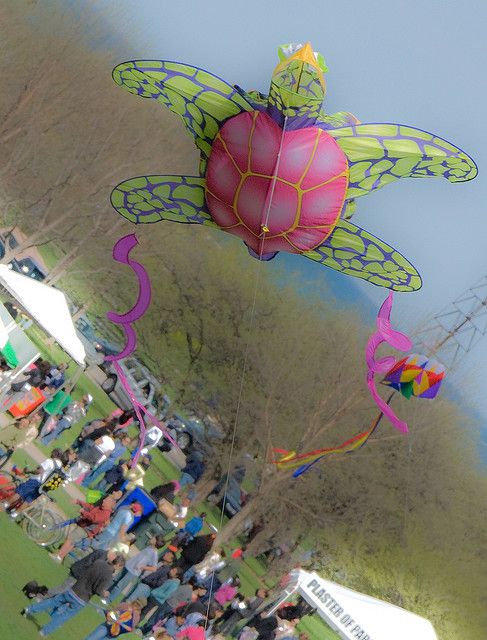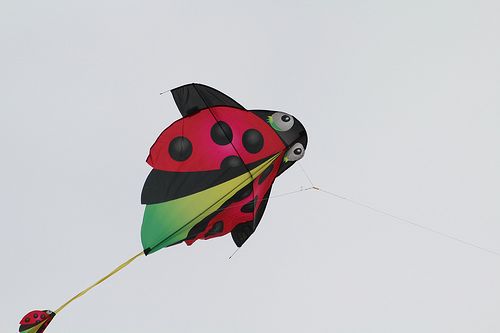Kite Shapes
Which Are Best for a Kite to Fly?
There are some fairly unusual kite shapes in these half-dozen large photos, I think you'll agree! That's quite deliberate.
People sometimes wonder what is the best shape for a kite to fly. The truth is, with the right knowledge and experience, almost any shape can be made to fly. And it can fly well, what's more! If it's light enough, has a bit of bow and/or something draggy hanging off the lower end, and is bridled appropriately, it'll float way up there.
(This motley collection makes my MBK designs look pretty dreary in comparison! Unless the thought of flying your own creation excites you more than oohing and aahing over someone else's. ;-) Are you a "how it flies" or a "how it looks" kind of person?)
So, further down this page are the photos, from the Flikr community to you, showing some quite unusual designs.
On this site, there's more kite-making info than you can poke a stick at. :-)
Want to know the most convenient way of using it all?
The Big MBK E-book Bundle is a collection of downloads—printable PDF files which provide step-by-step instructions for many kites large and small.
Every kite in every MBK series.
Some Unusual Kite Shapes!
This design could be called a Cowboy Duck kite and would not be out of place on my Funny Kites page! What a mixture of kite shapes it is. The upper end looks like half a rokkaku, while the bottom end vaguely resembles a roller.
I like how the lines tethering the lower sail help to define the edges of the face. Even if the lines were not there, the overall effect is still that of a face. Well, it's a cartoon-duck head, anyway. The design seems pretty sound, actually. I can imagine it flying high and stable on a long line.
Well, the owner and creator of this design has stumbled across it here—and has provided extra info. The design is named "Agent P." P for Platypus, that is! So I was half right about the duck bill. :-)
Also, this was a very successful kite. In 2010 the American Kitefliers Association selected it as "best flying kite."
It's not often you come across a genuinely asymmetric kite. In this case, the main lifting portion of the design is based on a delta. However, from the trailing edge back, the left and right sides have several differences in outline.
But, of course, the thing that leaps out at you is the very appealing panda image! A real attention-getting kite, is this one, even if its size is not particularly impressive.
The basic outline of this kite has some similarities to the well-known butterfly-kite shape. That is, it has an upper and lower set of lifting surfaces, with a central lifting surface as well. On a butterfly, it's the single set of wings that takes on this general shape, since the body is either painted on or a quite slim 3D construction.
This turtle has realistic "flippers" for sails, surrounding a "shell," plus a 3D body that inflates from the "mouth" air vent. All up, it's a fairly uncommon creature kite, if you ask me! I can't imagine it being a super-efficient flier. But as long as it stays up there, showing off its looks, that's all that is needed.
This 3D shark kite shares some similarities to the turtle in its basic configuration. That is, flat sails are coupled with a semi-inflatable 3D body. The realistic tail, dorsal fin, and mouth detail combine to make a smile-provoking kite! It has the ability to make a very funny first impression.
Again, I don't think anyone would buy something like this for its flying characteristics! Part of the humor lies in the fact that it is not as realistic as one of those giant inflatable killer-whale kites, for example. Do you agree?
This ladybug kite is quite a unique design! It's a really creative "art kite." The general outline is very roughly like a diamond-kite shape, in that the maximum sail area occurs less than 50 percent of the distance from the nose to the tail end. Of course, the different-colored segments making up the "wings" ensure that no-one would ever point at it and say "oh, look at that diamond kite!"
Don't you love the tail on this thing—another little ladybug! Well, I'm sure it works. Anything light enough and with enough air resistance will work as a stabilizing kite tail.
Now, I've seen this rotating-hex-box-kite idea in a kite-shop listing or two but decided to include it here anyway. It's just so far removed from most kite shapes people are familiar with! In fact, I saw one of these at a recent festival, quite high up and rotating slowly and mysteriously in the breeze. Have another look at the photo, and see how those little triangular sails are set at an angle to the breeze.
OK, this hexagonal box kite is hanging up indoors. But just imagine it on the end of a flying line, with a long rod poked through those axle holes so the whole thing can rotate without snaring the bridle lines. It's an interesting box kite, indeed.
As mentioned earlier, there's more kite making on this site than you can poke a stick at. :-)
Want to know the most convenient way of using it all?
The Big MBK E-book Bundle is a collection of downloads—printable PDF files that provide step-by-step instructions for many kites large and small.
That's every kite in every MBK series.






